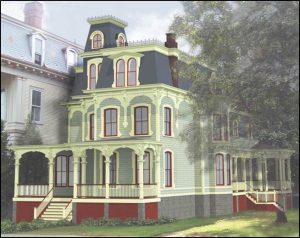In recent weeks, I have shared with you several of this city’s most important and inspiring preservation success stories: the Adelphi Hotel, the Batcheller Mansion Inn, and the Adirondack Train Station.
These architectural landmarks are with us today because caring and committed people and organizations decided these buildings are integral to Saratoga Springs’ character and history that they had to be saved. Thanks to vision, creative solutions, hard work, and invested resources, these important buildings continue to contribute immeasurably to the experience and economy of Saratoga Springs.
The Saratoga Springs Preservation Foundation feels that the historic Winans-Crippen House at 66 Franklin Street deserves to be preserved like the others mentioned above. The Design Review Commission (DRC), which is the body charged with the responsibility to protect and enhance the landmarks and historic districts of the City, needs to consider the value of this historic resource to our community as it reviews an application to allow its demolition, leaving nothing but a vacant grass lot.
Like the Adelphi Hotel and Batcheller Mansion Inn, the Winans-Crippen House was built in the 1870s. It was owned first by David Winans, a local merchant, and subsequently sold to George Crippen, owner of a dry goods business and later a women’s dress company. The house was designed by one of Saratoga Springs’ most important architects, J. D. Stevens, who designed some of Saratoga Springs most notable buildings, including the United States and the Grand Union hotels that once stood on Broadway. The three-story, 4800-square-foot Second Empire building stands among a collection of 19th century structures in Franklin Square, whose architecture documents the growth of Saratoga Springs as one of the most important resort destinations in the nation. For this reason, 66 Franklin Street is listed on the National Register of Historic Places as a contributing structure to the West Side – Franklin Square Historic District.
The building is not a hazard to the public. The building has been temporarily stabilized and inspected by a structural engineer who has confirmed the building is not in danger of collapse. If the right developer can be found, the building can be rehabilitated, and the Foundation is offering a $50,000 grant as an incentive to see the building preserved.
Rather than the owner continuing to attempt to demolish the building – which has been vacant since 2006 when the interior was gutted in preparation for rehabilitation – we at the Foundation hope he will join with us in a serious effort to find a new owner with vision for preserving the building for any of number of uses allowed by its current Urban Residential 4 zoning which allows single or two-family residences, neighborhood bed and breakfasts, senior housing, private schools, or churches and religious institutions. Since the Franklin Square area has a mixture of architectural styles and uses, and the Foundation would support the development of the property for a commercial use.

Proposed Restoration of 66 Franklin Street
Several local architects have developed concepts, the most promising of which is offered by Thomas R. Frost Jr. of Frost Hurff Architects. Frost proposes rehabilitation of the house and construction of a two-story carriage house on the adjacent lot to create a spectacular downtown residence. He envisions a house that would include five bedrooms and five-and-a-half baths, along with a two-parlor living room, a formal dining room, kitchen and office. The carriage house on the adjacent lot would have a three-car garage below and a two bedroom apartment on the second floor.
The DRC will hold a public hearing on the fate of the Winans-Crippen House Wednesday, August 15, at 7 p.m. in the City Council Chambers at City Hall. The Foundation is advocating for the denial of the demolition application. Many in the community fear that if the DRC does not allow the demolition of the structure it will continue to deteriorate and be a blight on the neighborhood. That will not happen. The City Court has ordered the owner to bring the exterior of the property into compliance of the New York State Property Maintenance Code if he is not granted permission to demolish the structure.
If you love the history and architecture of this great city and you do not want to see the loss of this significant piece of history, the Foundation encourages you to attend this important meeting or write a letter to the DRC supporting its preservation.
